a true heritage tomato variety

In 2002 - five years ago - we designed the first page on how we grow tomatoes - see here.
This is what we have learned in the past 5 years, based on trial and error. We invite all readers to share their comments - please click here to write to us.
Over the years we experienced up to 20% harvest lost to bottom-end rot - but in 2005 the percentage seems to be less than 2% on Memorial Day (virtually 0 in 2007).
Mississippi State University published this page on fruit bottom-end rot. Click here.
That web page does not apply to us because, as biodynamic gardeners, we DO NOT fertilize, nor IRRIGATE! We do not water any crops because we believe that by avoiding watering the vines will develop stronger and deeper root systems, thus finding the moisture in the soil and self-regulate the need of moisture for best fruit development. 2005 was a year of severe drought in SE Wisconsin ... again this no-tilling, plastic-mulching and no-watering method proved to produce high-quality and high-yield tomato vines.
NOTE: We live 2 blocks West of Lake Michigan and have sandy soil under the heavily amended top soil - that means 20 cubic yards of Father Dom's compost per 1000 sq.feet of garden each year. Click to read more on Father Dom's compost.
How did we minimize this problem so much??
You can read all about that on the page published in 2002 - except for these changes:
- we now use metal 7 1/2 T-posts (6 feet above ground), instead of wood. Wood poles break during storms when heavily loaded with tomatoes :-( ... and with metal we have much less trouble with caterpillars.
- in 2002 we planted 100 vines with about 2 feet spacing - possibly bottom-end rot is much reduced with greater spacing and better ventilation ... now we space the rows 4 feet and each pole 2.5 feet apart. With even more spacing in 2007 we have increase the pollination and reduced the bottom rot.
- but the true magic may be in the flower pollination of this heritage variety, so please read on.
Many years ago we thought to be smart and planted all kind of tomato varieties, but only ONE is giving us every year the results that we look for - juicy sweet, meaty tomatoes (with very small seed pockets) that are great in salads, sandwiches, but mostly end up frozen or processed for tomato paste. If you are interested in my tomato paste processing, click here.
- The first attribute is sweetness - we measured vine riped tomatoes above 5 BRIX count (compared to the below "2.5 BRIX count" that you purchase all the time at your favorite grocery store) - for more info on BRIX count to measure sweetness of these tomatoes click here and scroll down to the picture of a refractiometer.
- It's all in the name: Kenosha Paste - that is because these vines are the result of seed saving for many generations. Here in Kenosha Italian families have grown these tomatoes for their kitchen needs. Every year we save the seeds of the 5 best tomatoes picked from 5 different vines of the same variety - the seed for next years' vines is removed from tomatoes that have the "best shape" to avoid bottom-end rot - we believe that the "pointy" shape is less subject to bottom-end rot.
- Most tomato varieties self-pollinate before the flowers open - and you can grow many varieties next to each other. Exception is found with tomatoes that have potato-leaves and/or grow beaf-steak shaped fruit. This "wide" shape of fruit are actually two tomatoes growing together as one. We have frequently found such shapes on Kenosha Paste vines (see pictures) and therefore we must assume that this variety is prone to cross-pollination. To keep the seed of this variety pure, it is advisable not to grow any other variety closer than 200 feet.
- We have noticed that bottom-end rot shows very early in the fruit development stage. As this year we only had to pull less than 20 blemished fruit (from about 10 vines out of 60 total crop) - and most fruit next to the blemished ones has no signs of rotting ... we guess that the problem is NOT in the vine strength, but the condition must occur at the time of pollination of the sigle flower. It is a good idea to pull the blemished fruit as soon as you see it, but if you miss it ... bottom-end rot DOES NOT spread to other vines or fruit on the same vine.
- Also we noticed that fruit developing a "pointy" shape is less subject to bottom-end rot than fruit that grows in broader shape (see pictures below).
As you move your mouse over the pictures, you'll read the [alt text] comments. The pictures show the bottom-end rot condition, the heritage tomato "Kenosha Paste" in different shapes and sizes - pictures taken on Sept. 5 , 2005 - this variety of tomato and this method of growing allows the harvest of fully matured fruit by the end of September ... with no green, unripen fruit to dispose off.
Also shown are minor problems - found on very few tomatoes - cracking, top-cracking and fruit damage due to caterpillar. Every year 1 or 2 vines do not develop the desired height.
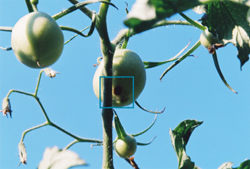
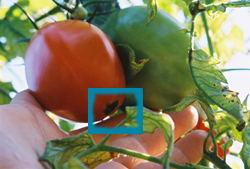
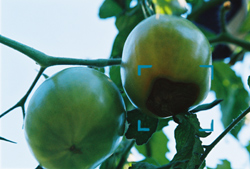
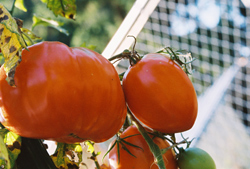
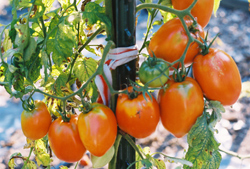
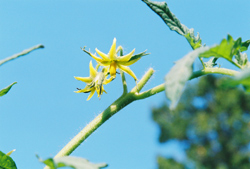
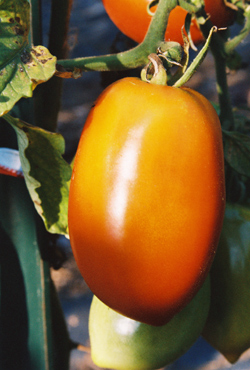
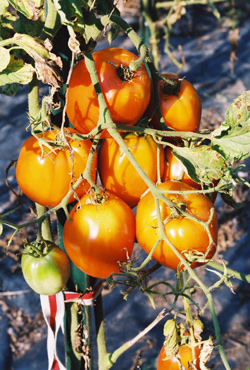
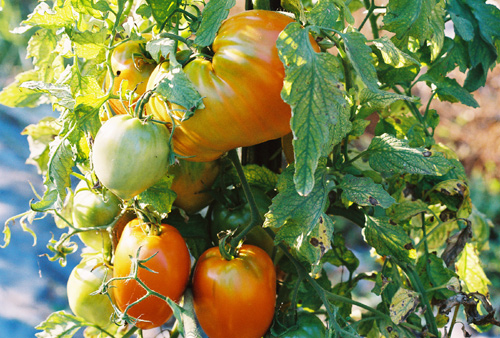
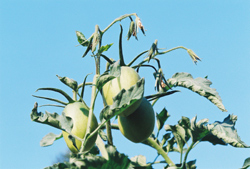
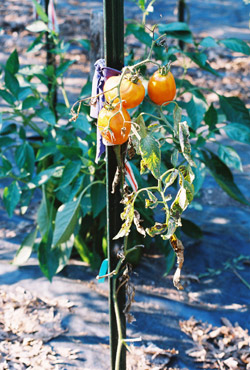
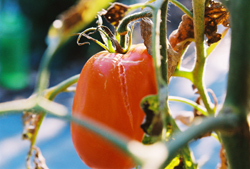
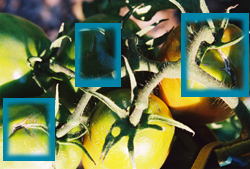
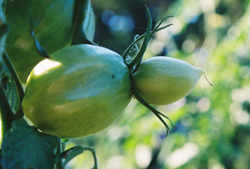
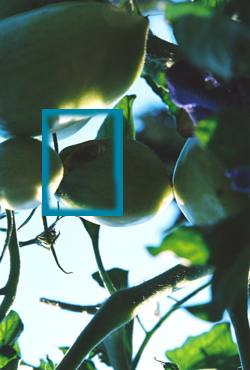
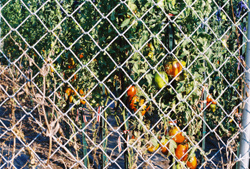
Black plastic covers the whole area to prevent weed growth.
Fence and plastic are removed at the end of the season and stored through the winter. In the spring we grow climbing peas on the fence.
Forward this link; it will take them to the free subscription page.
http://www.curzio.com/N/subscribe.htm
If you need help subscribing please drop us a note; we can do that for you.
Looking forward to meet you at the Kenosha HarborMarket this Saturday, or some day.
Your friend will be under the white tent,
Curzio